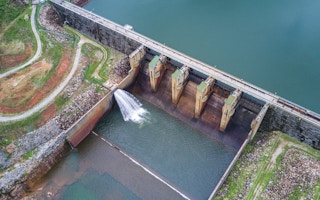Over the past year, the pace of hydropower development along the mainstream of the Mekong River in Laos has picked up, fuelled by long-term funding agreements. Chinese and Thai hydropower project investors have been signing Power Purchase Agreements (PPAs), which usually cover a 30-year period, with the governmental Electricity Generating Authority of Thailand (EGAT).
Thailand is the largest investor in Laos’ power generation sector. In 2016, Thailand signed an agreement to purchase 9,000 megawatts (MW) of electricity from Laos over the following two decades, a figure that increased to 10,500 MW with the signing of another agreement in early 2022.
Yet civil society and researchers have scrutinised Thailand’s Power Development Plan (PDP), which sets out the country’s roadmap for achieving its energy security, efficiency, and sustainability goals. Thailand has historically had a reserve electricity margin in the 40 per cent range, far above the international norm of 15 per cent. These critics argue that Thailand does not need the energy it has committed to from Laos in recent years.
Despite being increasingly hard to justify economically and environmentally, Thai investment in Mekong hydropower nevertheless continues. The situation reveals a deep disconnect between financiers and the consequences of their investments.
Problematic hydropower
Controversy surrounds hydropower development on the Mekong River’s transboundary mainstream and tributaries, because it has major impacts on the river’s hydrology, interconnected ecosystems and sediment flow. It also has implications for the food security and livelihoods of the 60 million people who live in the Lower Mekong Basin.
On the Mekong’s mainstream, there are currently 11 operational dams in China (where the river is known as the Lancang); two operational and seven planned dams in Laos; and two planned dams in Cambodia. While China has been building dams on the river since the 1990s, the pace of hydropower development in Laos has picked up in the past decade.
“
The Thai energy sector is largely sheltered from bearing responsibility for the environmental damage associated with its investments.
In 2018 and 2019, while the controversial Xayaburi and Don Sahong dams were under construction in Laos, the government proposed building four additional dams on the river’s mainstream, at Pak Beng, Pak Lay, Luang Prabang and Sanakham. Each regional consultation process was organised and carried out by the Mekong River Commission (MRC) in quick succession, although the rationale for these dams was later undermined by the absence of PPAs or even an energy buyer.
In February 2018, EGAT stated that a decision on signing a PPA for the proposed Pak Beng dam was deferred until an ongoing review of Thailand’s PDP was completed. But in November 2021, the Thai National Energy Policy Committee agreed to buy power from the under-construction Pak Beng, Pak Lay and Luang Prabang dams; EGAT has since signed PPAs for the Luang Prabang and Pak Lay dams.
Looking closely at PPAs and the Thai energy sector raises several critical questions: Are Thai investments in Mekong hydropower justifiable, in terms of necessity and equity? And is the energy sector evading accountability for the negative environmental consequences of its investments?
Consultation and mitigation: a mere rubber stamp?
Concerns around the environmental and economic impacts of Mekong dams have long been highlighted by civil society. They have also been expressed via the MRC’s Procedures for Notification, Prior Consultation and Agreement (PNPCA), a six-month consultation and evaluation process that any hydropower dam proposed for the river’s mainstream must undergo. Accordingly, the Laotian government initiated six separate PNPCAs for the Xayaburi, Don Sahong, Pak Beng, Pak Lay, Luang Prabang and Sanakham dams.
The merits of the PNPCA process include making project documents such as Environmental Impact Assessment (EIA) reports publicly available. In the case of the Xayaburi dam on the Mekong’s mainstream in northern Laos, its PNPCA also led to a 19.4 billion baht (USD 554 million) redesign of the dam’s fish ladder. This was done to address concerns that the dam, which became operational in 2019, would pose a barrier to fish migrations.
Despite this, the PNPCA process has been criticised by Thai civil society as a meaningless, “rubber stamp” affair: despite outstanding concerns around inadequate local representation, poor quality EIAs, and a lack of understanding of the dam projects’ transboundary impacts, the Laotian government pressed ahead with construction.
Investing in energy Thailand doesn’t need
Thailand doesn’t necessarily need to import more energy, but typically inequitable and opaque PPA arrangements continue to be signed for hydropower projects in Laos. Researchers have pointed to EGAT’s monopoly over electricity distribution and generation in Thailand, which creates a propensity to over-invest in energy projects. This is due to EGAT’s cost-plus tariff system, which guarantees that the authority earns revenue based on the electricity it sells, and allows EGAT to pass the costs of over-investment to consumers.
In addition, although Laos sells power to Thailand for USD 0.05 per kilowatt-hour (kWh), during the dry season Laos imports power from Thailand at almost twice that rate: USD 0.11 per kWh. Mekong hydropower dams are touted as necessary to meet Thailand’s energy demands and the Laos government’s economic development goals. Nevertheless, questions remain over how widespread these benefits can be under such inequitable arrangements.
Absence of accountability in energy planning
The PPA for Xayaburi – the first dam to be constructed on the mainstream of the Lower Mekong River, built and financed by Thai entities – exemplifies concerns around the inequity of these agreements and the lack of civil society input.
In August 2012, 37 Thai villagers filed a landmark lawsuit against five Thai government entities, citing concerns over the dam’s impacts on the river and livelihoods. Those entities included EGAT, thereby challenging the validity of the Xayaburi PPA and the legitimacy of the Thai cabinet’s approval. The lawsuit was eventually dismissed in August 2022, on the grounds that the PPA “had no clear and direct impact on the environment and people” and “the defendants had followed and conducted the proper [PNPCA] procedures”.
While this was happening, an independent review of the Xayaburi Dam’s PPA by the energy policy researcher and analyst Ashwini Chitnis was published in 2013. Commissioned by the NGO International Rivers, Chitnis argued that the terms of the 29-year contract placed the government of Laos in a risky and disadvantageous position with EGAT. According to Chitnis, the contract could potentially impinge on the ability of Laos to control and meet its own energy and water resource demands.
Participatory energy planning
The decision to press ahead with the Xayaburi dam illustrates a major disconnect between energy-related decision-making and its consequences and costs on the ground (and in the water). The Thai energy sector is largely sheltered from bearing responsibility for the environmental damage associated with its investments.
The MRC’s PNPCA process has, to some extent, created limited avenues for public participation in Mekong hydropower decision-making. At the very least, the process has increased public scrutiny of Mekong hydropower development. But such opportunities to influence the energy sector have been limited.
Thailand has held public hearings on its PDP since 2007, yet its energy sector is still largely characterised by powerful interests. This facilitates a lack of transparency, accountability, and checks and balances in decision-making.
Opportunities for independent checks and balances and public participation in Thailand’s energy sector correlate with the openness of its democratic space. The academic Bruce Missingham described the 1990s as: “a decade of rural organising, political activism and protest such as had never before been seen in Thailand”.
During this time, Thai environmental civil society had some success in challenging the construction of the country’s large hydropower dams in the 1990s, as seen in the Assembly of the Poor protests against the Pak Mun Dam in the northeast. And in 2022, Thailand’s House Committee on Foreign Affairs called for a deferment of the PPAs for the Pak Beng and Sanakham dams, in response to a petition filed by the Network of Thai Mekong People. As part of the post-coup National Assembly formed during the 2019 general elections, the committee included an MP for the Move Forward Party (MFP), who noted that the dams would not benefit Thailand. The MP also said the relevant government agencies did not provide satisfactory responses to EIA queries.
This year’s Thai general election saw the electorate reject conservative, military-linked parties for the reform-oriented MFP, which has pledged progressive environmental policies. However, Thailand’s forthcoming government will nevertheless sideline the MFP by design. This makes it more important than ever for international organisations, donors and the public to question business-as-usual approaches to energy planning in Thailand.
Entrenched institutions and interests cannot be easily reformed, but this moment in Thai history is an opportunity to consider alternative development pathways. Incorporating meaningful public participation into energy decision-making could also lead to more just and equitable outcomes. In doing so, Thailand could bridge the dire disconnect between the energy sector and the environment in the Mekong River Basin, and even lead the way for sustainable development in the region.











